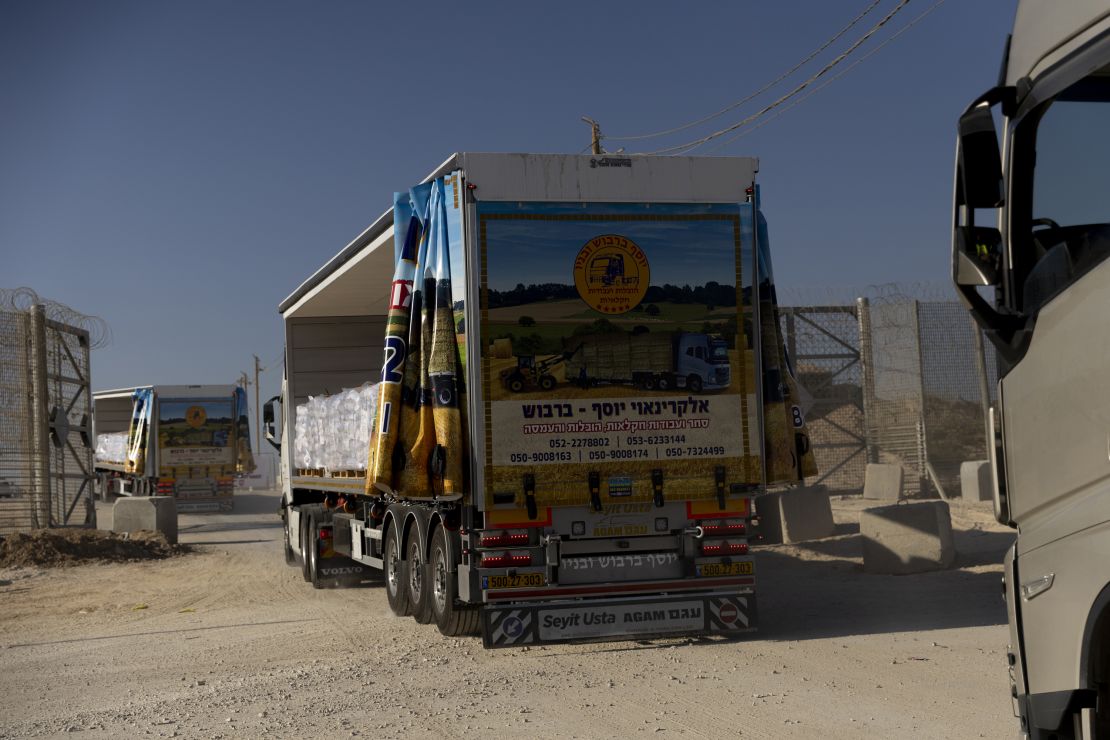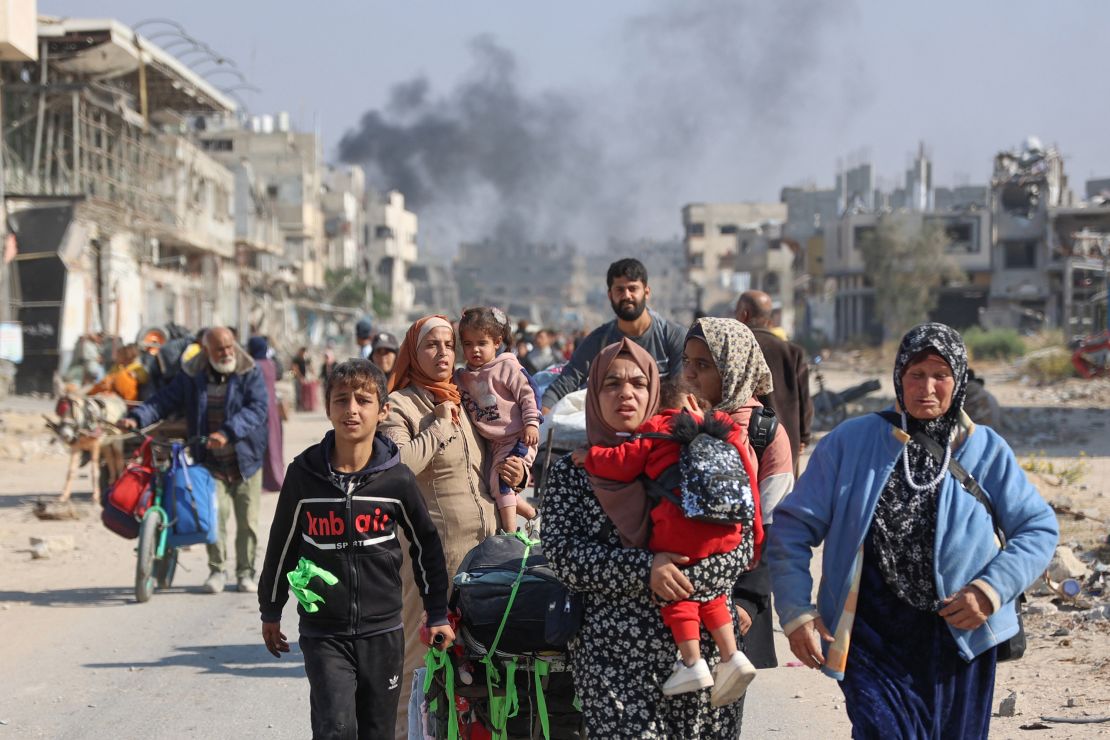A US deadline for Israel to improve getting humanitarian aid into Gaza has expired, with the Biden administration assessing that Israel is not blocking aid and so is not violating US law governing foreign military assistance.
The State Department said that while changes were needed, progress had been made - so there would be no disruption to US arms supplies.
But the US view is a stark contrast with the bleak picture on the ground, where much of the aid that reaches Gaza is not being distributed.
Civilians fleeing northern Gaza after weeks of intense Israeli military operations tell of a chronic lack of food and people dying of hunger, as aid agencies warn that the area is on the brink of famine.
“We have not seen any aid, and no-one has sent us food,” 63-year-old Umm Muhammad Al-At’out told CNN this week. “Our children have died of hunger and thirst.”
Her account of people dying from hunger was supported by others CNN spoke to in northern Gaza, where the Israeli military resumed ground operations early in October.
Abu Ahmed Subaih from Beit Lahiya told CNN that he had walked for miles with his parents, who are in their 80s. “There is no food of any kind,” he said.
A woman who gave her name as Ghalia and said she was 83 told CNN: “We no longer know vegetables, meat or fruits. We used to live on canned food, and now there’s no canned food.”
The accounts of desperate civilians echo the the World Health Organization’s warning last Friday of “a strong likelihood that famine is imminent in areas within the northern Gaza Strip.”

On Wednesday, Dr. Hussam Abu Safiya, director of Kamal Adwan Hospital in Beit Lahiya, told CNN that the hospital had received dozens of cases of malnutrition among children and adults.
Multiple factors have contributed to what aid agencies are calling the worst point for the humanitarian situation in Gaza since the war began in October 2023.
They include ongoing Israeli military operations, evacuation orders affecting hundreds of thousands of people, a breakdown in law and order that has led to looting of aid convoys, a lack of truck drivers and the frequent denial of passage for aid by Israeli authorities.
Last month, the Biden administration gave Israel a 30-day deadline to take specific steps to improve the humanitarian situation in Gaza, including boosting commercial traffic and ending the isolation of the north.
As the deadline expired, the US State Department said it had “not made an assessment that the Israelis are in violation of US law” and that they would face no penalties.
Much of the aid community disagrees.
On Tuesday, eight humanitarian organizations said the Israeli government “not only failed to meet the U.S. criteria that would indicate support to the humanitarian response, but concurrently took actions that dramatically worsened the situation on the ground, particularly in northern Gaza.”
One of those groups is Mercy Corps, whose director Kate Phillips-Barrasso, told CNN that commercial traffic into Gaza had “ground to a complete halt.”

“We really are at a tipping point in terms of this turning into a catastrophic food insecurity situation,” Phillips-Barrasso said.
According to the World Food Programme, the average number of trucks entering Gaza fell to just 58 per day in the second half of October, the lowest level since November last year.
Before the war began, around 500 commercial and aid trucks were entering each day.
COGAT, the Israeli agency that approves aid shipments into Gaza, said Saturday that 713 aid trucks had arrived in northern Gaza through the Erez West crossing since the beginning of October. But much of this aid remains at the crossing point.
The same applies to Kerem Shalom, which borders eastern Gaza. COGAT told CNN Wednesday that 900 truckloads were waiting on the Gaza side of Kerem Shalom, the maximum capacity. But it added that supplies from 122 trucks had been picked up Tuesday.
Aid organizations have often said that distribution of food and water amid Israeli strikes, evacuation orders and the absence of secure corridors is almost impossible.
They also say that Israeli authorities frequently delay or deny passage within Gaza. The World Food Programme (WFP) told CNN Tuesday that planned deliveries to parts of northern Gaza in most urgent need had been denied by Israeli authorities.

Last week, it said, an approved convoy of ten food trucks was held for two hours in Jabalya, “where some of the food was offloaded by people who surrounded the trucks.”
The food never reached locations where displaced Palestinians were sheltering, it said.
Joyce Msuya, acting UN under-secretary-general for humanitarian affairs, told the UN Security Council Tuesday that Israeli authorities were “blocking humanitarian assistance from entering North Gaza, where fighting continues, and around 75,000 people remain with dwindling water and food supplies.”
In response to a request for comment, COGAT told CNN that “the State of Israel allows and facilitates the entry of aid into the Gaza Strip, particularly to its northern area.” The Israeli military “through COGAT, maintains regular communication with international aid organizations to monitor warehouse stock levels, as well as ongoing contact with hospitals regarding the humanitarian needs on the ground.”
A planned 14-truck WFP aid convoy had intended to deliver supplies to Beit Hanoun and the Indonesian Hospital in Jabalya, but only two trucks reached their destination due to “delays in movement authorization and crowded routes,” OCHA said on Tuesday.
The Israeli military said Tuesday that “hundreds of food packages and thousands of liters of water were delivered to distribution centers for the civilian population remaining in the Beit Hanoun area” on Monday.
But shipments of such size only scratch the surface of the immense need.
In addition to the lack of aid, 13 months of constant air strikes have left agriculture and industry in Gaza in ruins. Most of the enclave’s agricultural land is in the north and along the eastern border with Israel, areas from which hundreds of thousands of people have fled.
The vast majority of Gazans have little or no work and can’t afford to buy food at inflated prices.
Saber Salem, a father of 10 now in Gaza City, told CNN Wednesday: “Every two months maybe we would get an aid coupon. There is nothing to buy and if available the goods are expensive.”
Communal soup kitchens and bakeries are also closing or short of supplies.

Amjad Al-Shawa - head of the Palestinian Non-Governmental Organizations Network (PNGO) in Gaza – told CNN that soup kitchens which served 300,000 people a day with a hot meal had now closed, and so had many bakeries.
There is also the issue of profiteering. On Sunday, dozens of people marched through a market in Gaza City, chanting: “We are the people, you merchants are thieves!”
One young man told CNN: “They are selling a kilo of sugar for 80 shekels instead of two.”
The pervasive desperation has led to frequent incidents of looting, both of warehouses and convoys. Late in October CNN filmed a desperate brawl for bread at one of the few functioning bakeries.
But much of the looting is by organized gangs.
The president of Gaza’s Transportation Association, Nahd Shuheiber, said this week there has been “an increase in the theft of trucks loaded with humanitarian aid,” because of a lack of police.
Police in Gaza have often been targeted by Israeli strikes as they are seen as being associated with Hamas.
Shuheiber said that “bandits” near the Kerem Shalom crossing had been stealing from the trucks, “creating a state of chaos under which we are unable to operate effectively.”
Barroso-Phillips of Mercy Corps told CNN that needs in Gaza far outstrip what is getting past its borders.
“And as a result, we are likely to have people starving to death literally miles away from where food is available.”
Khader Al-Za’anoun of Wafa, the official Palestinian news agency, contributed reporting.



